
(Image credit: NASA/Unsplash)
Finding a sustainable, affordable, and consistent energy supply can be a roadblock to decarbonization as the world moves from burning fossil fuels to using renewable energy. In some cases, we've turned to batteries to store energy for the days when renewables like solar and wind aren't generating enough power to meet demand. Lithium-ion batteries, like those used for electric vehicles and storing backup solar power, are the clean energy storage of choice because they are lightweight and fast-charging. But lithium-ion technology also has a growing list of sustainability and safety concerns.
In 2020, Yi Cui, a Stanford professor of materials science and nanotechnology, took a cue from NASA and made an energy storage breakthrough. NASA has used sustainable batteries for the solar arrays that power the International Space Station and the Hubble Space Telescope for decades. The organization’s batteries are powerful and durable, even in the rugged environment of outer space. But they utilize platinum, making them too costly for most clean energy applications on Earth.
Cui discovered a way to recreate NASA’s battery technology using a far more affordable metal: nickel. That same year, he founded the clean energy company EnerVenue to commercialize his innovation.
“Because this was a cost reduction play on an existing technology, we have been able to move fast. We have found a way to reduce costs drastically through material substitution and redesign, and that makes it easier to manufacture,” said Jorg Heinemann, CEO of EnerVenue. “It has characteristics similar to lithium-ion. But unlike lithium-ion, our batteries effectively last forever.”

Demand for these batteries is growing, and the company recently announced a new 1 million-square-foot production factory in Kentucky.
EnerVenue’s batteries are nickel-hydrogen based. A chemical reaction inside the battery generates hydrogen to charge them. As the battery discharges, the hydrogen oxidizes and turns back into water.
The batteries look like long scuba tanks — about 6 feet long and 6 inches wide. That makes using them while one the move nearly impossible, but they are perfectly suited for use in power plants, businesses and homes, Heinemann said. “We can meet any energy storage need as long as it is not mobile,” he said.
Though EnerVenue’s batteries utilize a pressurized tank, they reach peak pressure at approximately 5 percent of what a typical hydrogen fuel cell would reach. If pressure continues to build, the hydrogen is forced to recombine into water, which can be released from the battery as steam.
Unlike lithium-ion batteries, nickel-hydrogen batteries do not carry the risk of overheating and do not require a temperature-controlled storage site with hired staff for constant monitoring. They can be stored together in large quantities for their entire lifespan.

“Storing energy in the form of hydrogen is highly efficient and very durable and works almost as well in the hottest places and coldest places in the world as it does at room temperature,” Heinemann said.
Plus, nickel-hydrogen batteries have a lifespan of 30 years, equal to solar arrays and wind turbines. “Other batteries tend to wear out for the same reason a paper clip wears out when you bend it: There is a flexing mechanism,” Heinemann said. “Think of your cell phone. It can get warmer and thicker when it is charging. That is because the material in the battery is flexing. When you do that enough, it starts to not hold its charge well enough anymore and degradation accelerates. That doesn’t happen with our battery.”
Regardless of the relatively long lifespan, the company designed the batteries to be “cradle-to-cradle,” Heinemann said. EnerVenue employs a circular manufacturing model where the batteries’ parts can be removed and re-used without the risks that lithium-ion recycling carries.
“Batteries have always been things that wear out or we throw away,” Heinemann said. “We have to replace them or baby them. Those constraints don’t exist for us. Energy storage can last forever and be incredibly cost-effective as a result.”

EnerVenue is scaling up quickly after the success of its pilot programs. “We have proven that systems work in the field, and we have half a billion dollars of firm orders from customers,” Heinemann said. “We are really excited. Our order book is in excess of what I imagined it would be at this stage.”
The company is also exploring new and innovative applications for clean energy storage. “Because our battery is fire safe and does not require maintenance, we want to launch a new category of energy storage that allows us to build our batteries into unused storage areas, like in the ceilings of parking garages or crawl spaces of buildings,” Heinemann said. “Where there is dead space, our batteries could go there.”
Homepage image: NASA/Unsplash

Mary Riddle is the director of sustainability consulting services for Obata. As a former farmer and farm educator, she is passionate about regenerative agriculture and sustainable food systems. She is currently based in Florence, Italy.














